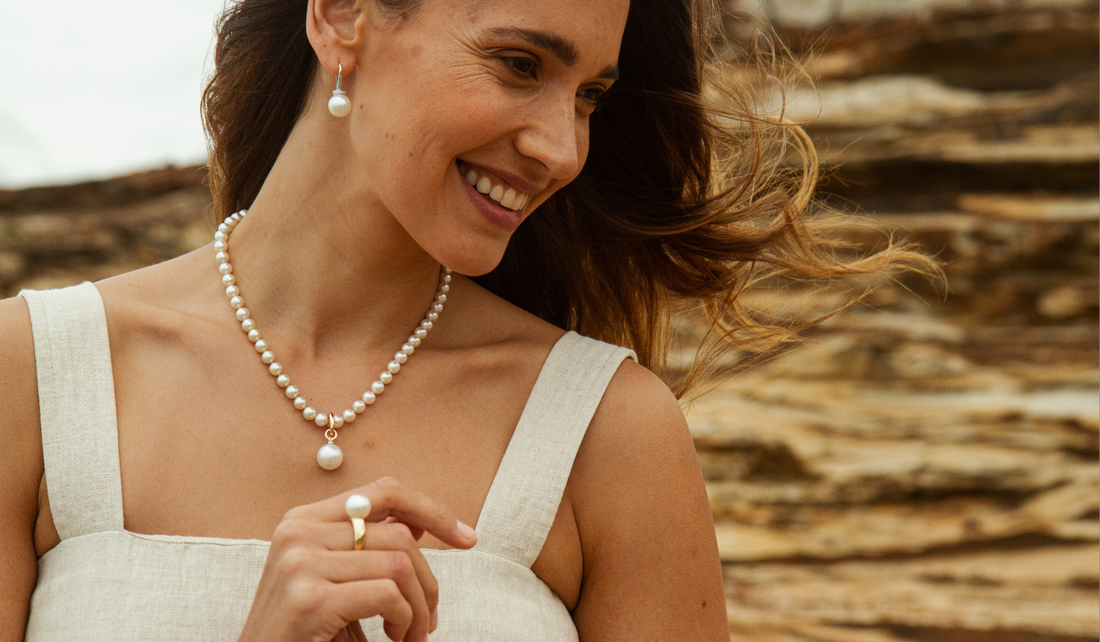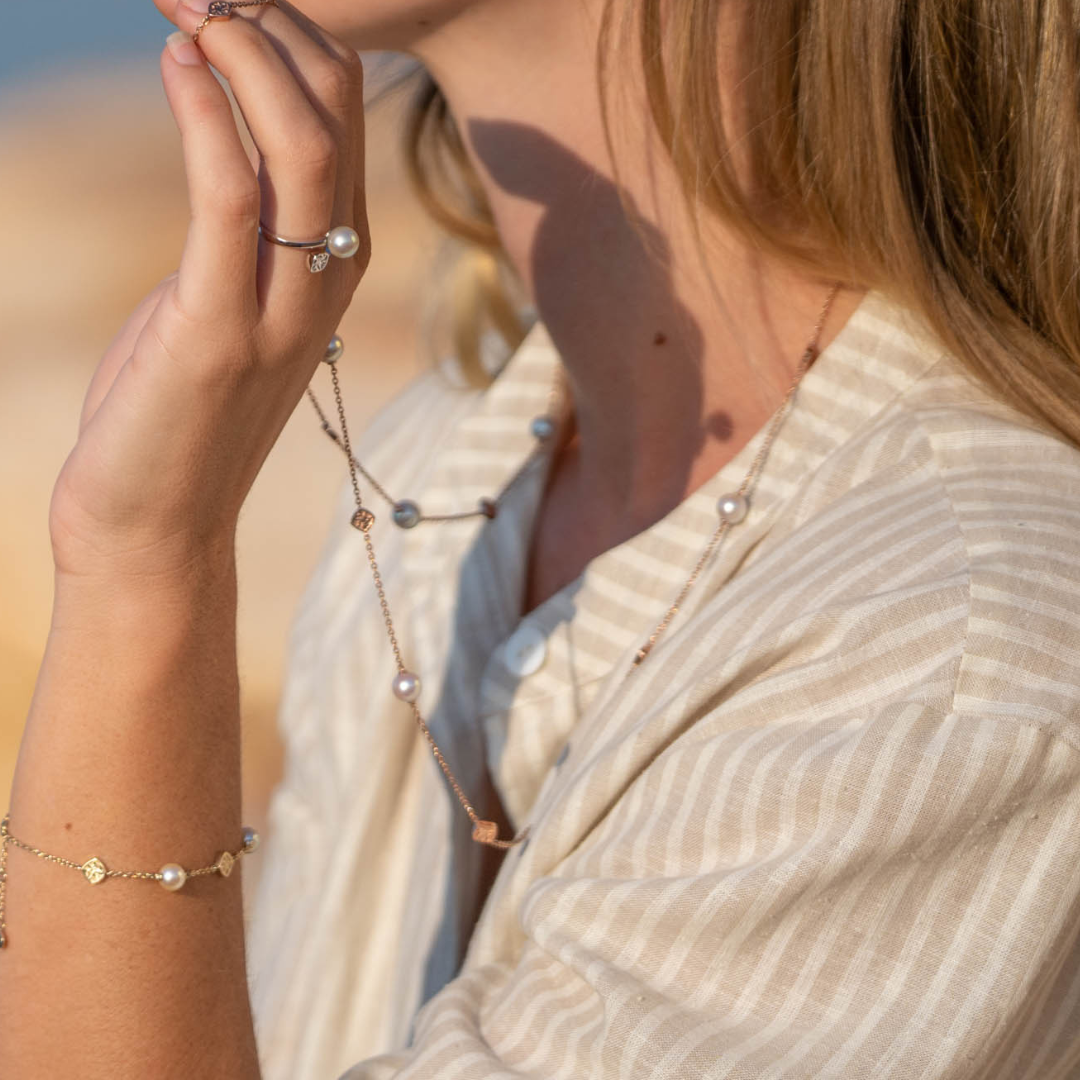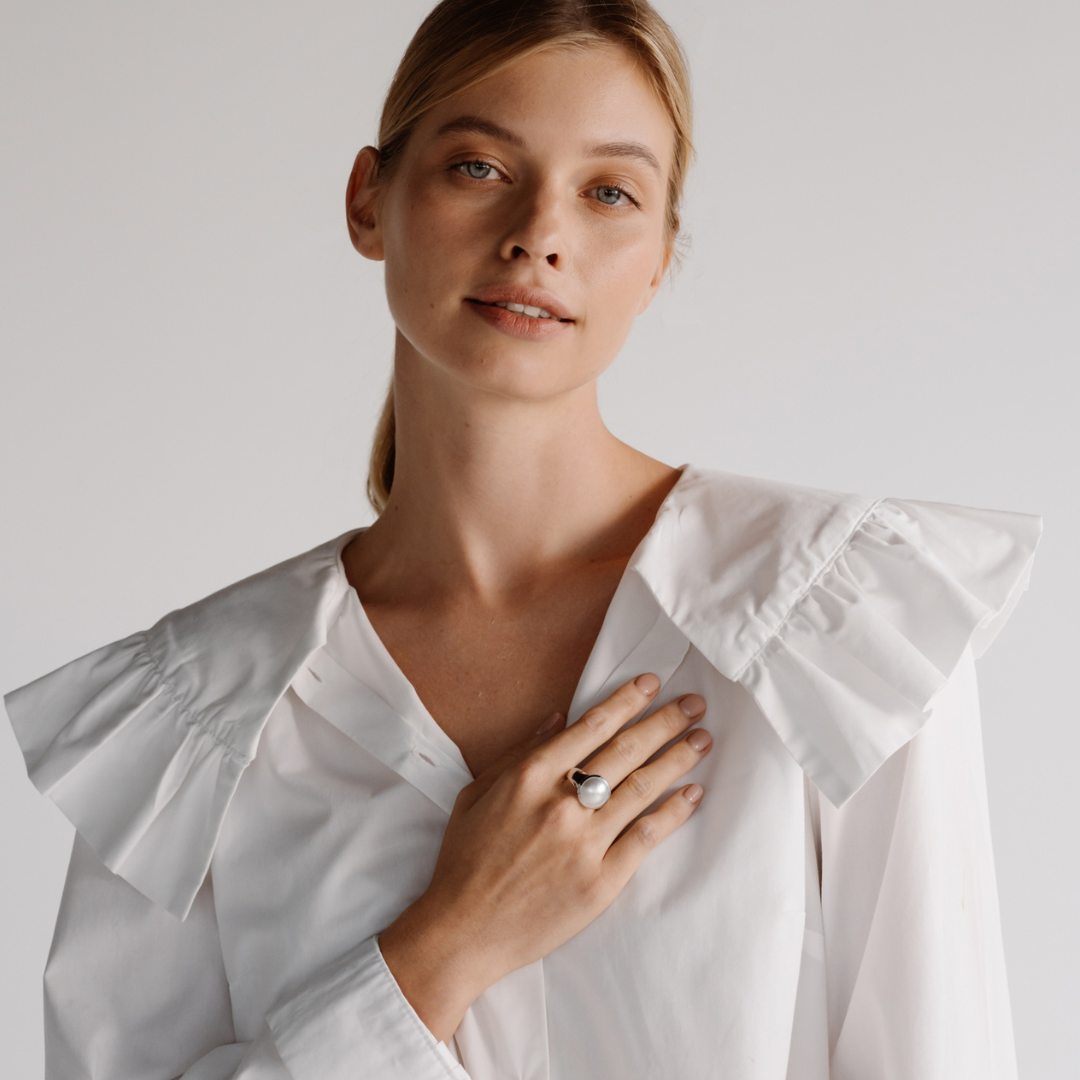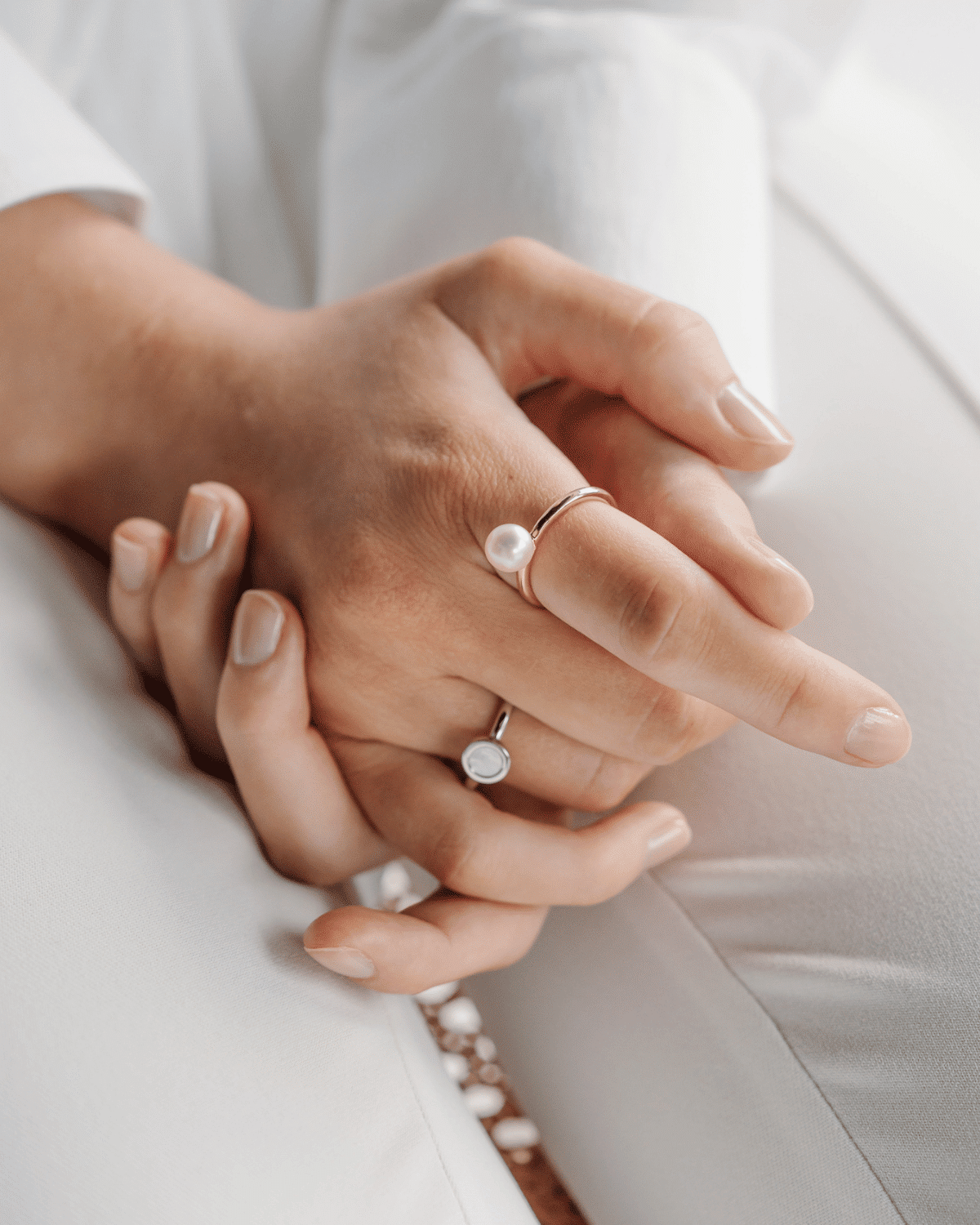How to Buy Pearls: Your Ultimate Guide

$0.00 AUD

Pearls are a timeless choice for both men and women offering a unique and elegant touch to any jewellery collection. As the only gemstones formed entirely within a living organism, pearls come in a variety of shapes, colours, and sizes. Understanding these differences is key to making an informed purchase. Our comprehensive guide will walk you through the types of pearls, how to choose the right one, and how to care for your pearl jewellery.
An Akoya pearl is a type of saltwater pearl that comes from the Akoya oyster. These oysters are mainly found in the colder waters off the coast of Japan, as well as Vietnam, Korea and Australia. China was a large producer of this pearl type, however, due to several factors, this is no longer the case.
One of the main reasons that so many of the world’s Akoya pearls come from Japan is because it was the Japanese son of a noodle store owner, Kokichi Mikimoto, (perhaps you recognise the surname?) who first learned how to consistently culture pearls. Mikimoto was then instrumental in creating the global cultured pearl industry, a remarkable story and one that we will cover in a future article. While their freshwater cousins average a whopping 20-50 pearls in a single culturing cycle, it would be a rare occasion where an Akoya pearl oyster would produce more than two.
Saltwater pearls are grown across Australia and Asia, and there are three main types of saltwater pearls, which include South Sea pearls, Tahitian pearls and Akoya pearls and these are considered to be more valuable than freshwater pearls. This is because Saltwater pearls take longer to cultivate, only produce a single pearl at a time, and have a thicker nacre. They also have a beautiful lustre and colour.
An Akoya pearl is a type of saltwater pearl that comes from the Pinctada fucata. These pearl shells are mainly found in the colder waters off the coast of Japan, as well as Vietnam, Korea and Australia. Our Akoya pearls are cultivated in NSW, at our Broken Bay Pearl Farm. As the Akoya shell is much smaller than the Pinctada maxima and is the smallest of all the pearl-producing molluscs, this is one of the reasons Akoya pearls are generally smaller than South Sea pearls, with most Akoya pearls measuring between two and eight millimetres. The colour of Akoya pearls can vary, so while most people think of white pearls when they think of Akoya pearls, there are many other colours to choose from.
South Sea pearls are a type of saltwater pearl and are considered the rarest of all types of pearls. They come from the Pinctada maxima shell, where the name “South Sea” originates from the location of the shell, as these shells are found in the southern hemisphere – particularly around northern Australia, Indonesia, the Philippines, Burma, and French Polynesia. Our South Sea pearls are sustainably cultivated in the pristine and remote waters of our Cygnet Bay Pearl Farm, located on the Kimberley Coast, WA.
Freshwater pearls are grown in rivers, lakes, reservoirs, and ponds – most of them coming from China. Freshwater pearls are usually less lustrous, have a thinner nacre, produce multiple pearls at a time and are cultured for a shorter time than their premium Saltwater pearl counterparts. It’s important to further note that freshwater pearls spend more time in a chemical bath to enhance their colour and lustre than they do growing inside a shell. At Pearls of Australia, we do not chemically alter or enhance our pearls – we sell them exactly as nature intended with their natural colour and lustre.
A Keshi or seedless pearl can form in the pearl sac or in the oyster’s outer tissue in addition to a cultured pearl. Sometimes the host shell rejects the implanted seed and a Keshi grows in its place in the pearl sac for the full cultivation period. Our Keshi pearls are grown at our Australian pearl farms. They are a beautiful by-product of pearling and are the rarest pearls in our harvest.
Absolutely! Pearls continue to be a fashion staple, seamlessly integrating into both classic and contemporary styles. From elegant strands to chic pendants, pearls are versatile and suitable for any occasion.
Pearls truly never go out of fashion, and even most recently, they continue to take centre stage in the fashion world.
Pearls in any form, from showstopping strands to petite pendants, are versatile for any occasion and you can incorporate them into your wardrobe.
Just like us, pearls come in a myriad of colours, shapes, and sizes so there’s bound to be something to suit every taste, and occasion.
Baroque pearls offer a modern twist on pearl jewellery and are considered more organic in shape while offering a unique statement for the wearer.
Keshi pearls are a beautiful by-product of pearling. They’re irregular in shape and are as close to a natural pearl as you can get in a farmed environment. Keshi pearls are known for their exceptional lustre and their unique shape makes this type of pearl extremely popular today.
Classic and timeless round pearls are the quintessential choice for any jewellery collection.
For a trendy, modern look, try layering pearl pieces of different shapes and sizes. Try mixing pearl bracelets, stacking pearl rings – the choice is yours!
The early 2020’s has seen pearls for men as the newest trend taking the world by storm. Specifically – pearl necklaces for men have risen in popularity, but traditionally have been worn by men throughout time.
Like buying pearls for women, buying pearls for men is down to personal preference and how they express their individuality. Whether you’re looking for a ring to mark an important milestone, a necklace to add a touch of luxury to your everyday look, or a bracelet to show your personality, we have something to suit every taste.
Pearl jewellery comes in many different styles and designs that can suit various occasions and the personal style of the wearer. One of the most popular choices is the classic pair of pearl stud earrings, which can be worn for any occassion! At Pearls of Australia we offer pearl stud earrings in a variety of pearl types - to suit the personal style of any individual.
For a show-stopper, a beautiful classic pearl strand necklace is the perfect choice for any formal events or to simply dress up your everyday attier. A strand of matched pearls elevates any outfit, but multiple pearl strands worn together adds an extra level of sophistication.
Both pearl bracelets and pearl rings are a fantastic way to showcase not only your personal style, but also the versatility of the pearl. We offer pearl bracelets paired with stunning gemstones as an option to showcase some colour in an outfit, or beautiful pearl rings complemeted by white sparkling diamonds to add drama to a cocktail event outfit.
When you’re buying any type of pearls it’s important to look for the following virtues of the pearl:
Pearls of Australia jewellery exclusively features pearls of good to excellent lustre. It is observed below the pearl surface and expressed through the sharpness of the image it reflects.
Our grading system for both South Sea & Akoya categorises Lustre as:
Pearls of Australia jewellery features only clean to lightly blemished pearls. Lightly and moderately blemished pearls can be matched as strands.
Our grading system categorises South Sea Pearls Surface as:
Our grading system categorises Akoya Pearls Surface as:
Pearls of Australia jewellery features all shapes of pearls however there is generally a larger diversity in shape from South Sea Pearls than Akoya Pearls.
Our grading system for both South Sea & Akoya categorises Shape as:
South Sea Pearl size usually range from 8 to over 20mm. Australian South Sea Pearls average size is bigger than their Indonesian and Philippines counterparts. Relative proportion and balance come into play here rather than size alone.
Akoya Pearl size ranges from 4mm – 10mm with the average sitting around 6.5-8mm.
Our grading system for both South Sea & Akoya expresses Size as:
millimetres (mm) or momme (3.75g) – which is the Japanese weight measure for pearls and commonly used for the international market.
Pearls of Australia jewellery only features the natural colours of pearls we grow.
Our grading system for both South Sea & Akoya categorises Colour as:
Most Australian South Sea pearls sit on the Silver – White Spectrum whilst Australian Akoya will produce the full range above.
Each of our pearls comes from our own pearl farms and are backed with a Certificate of Authenticity.
This certificate contains full transparency around the virtues of the pearl, including its lustre, surface quality, shape, size, colour and purity.
Pearls are the only gems born of a living organism. All Pearls of Australia pearls are of natural colour and lustre – never undergoing any chemical enhancement or treatment.
Any mechanical or chemical treatment or enhancement applied to a pearl may dramatically affect its structure, aspect and durability and must be disclosed.
Both saltwater and freshwater pearls are genuine but ensure authenticity by purchasing from reputable sources. Pearls of Australia provides a Certificate of Authenticity with every purchase, guaranteeing the pearl’s origin and quality.
We do have a guide to help you discern whether pearls are real or fake in our article.
It’s important to note that at Pearls of Australia, we only ever sell pearls that we grow at our very own pearl farms and each purchase includes a Certificate of Authenticity that highlights the origin, species, and details of that very pearl. By buying a Pearls of Australia jewellery piece you have peace of mind knowing that your pearl is indeed real.
If cared for properly, your Pearls of Australia jewellery will remain as stunning as the day it was purchased. Read about our tips to learn more about taking care of your pearl jewellery.


Our Australian South Sea pearls come from our Cygnet Bay Pearl Farm just north of Broome. They are cultured within the Pinctada maxima pearl shell. With pearls featured in the purest of white, this range boasts elegant jewellery pieces in rings, bracelets and pendant necklaces.
Our Akoya pearls Pinctada fucata are cultured at our Broken Bay Pearl Farm on the mouth of the Hawkesbury River just north of Sydney. This range features elegant options of pearl earrings, rings, necklaces and more. With high lustre these pearls are the perfect choice for a more vibrant and beautiful look.
Our collection of Australian-grown pearls offers unparalleled purity, rarity, and provenance. Explore our jewellery selection and use this guide to make an informed decision. Each Pearls of Australia piece includes a Certificate of Authenticity, ensuring the quality and origin of your pearl.
Now that you’re a pearl expert- we invite you to explore Pearl’s of Australia’s pearl jewellery and discover the perfect piece for you. We encourage you to use our pearl buying guide to make the best decision the next time you purchase a pearl jewellery item.

Prefer to talk to one of our Jewellery and Pearl experts before purchasing one of our Australian pearl pieces? They would love to help you in any way, please contact them either by sending an email to hello@pearlsofaustralia.com.au or call (08) 6478 6886.
Join our mailing list for regular sales, upcoming releases and insights into the world of positive pearling and ocean conservation